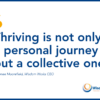Motorcycle riding, like organizational leadership, requires an ability to focus well out ahead. I make this connection in my mind as I’m looking down the zigzag mountain road that leads to my house. When first learning to ride, I used worry over every rock or patch of loose gravel in the road, keeping my vision on my machine’s front tire. Of course it’s that myopic focus which causes the worst kinds of motorcycle wrecks (read: fatal roadrash). When danger’s under your tire, it’s too late to react.
This little rumination stemmed from today’s session with one of my favorite clients: a vibrant senior executive running a major pharmaceutical organization. He shared what turned out to be a profound and refreshingly personal insight. Although a motivating leader, he discovered that his power to motivate springs from crises — those potholes of organizational life — and not from a dynamic vision of the future.
Whenever confronted with a big hairy ordeal, he said, his target becomes crystal clear, his adrenaline spikes, and he leads with the single-mindedness needed to conquer the challenge. In his view, he performs better under pressure than without it, and has thus surrounded himself with managers who are kindred spirits. Now leading his organization is a team of well-meaning, but compulsively crisis-driven, execs.
To be fair, this new leadership team has been a boon to the pharmaceutical company whose previous team’s efforts scored poorly by every measure: quality of services, employee satisfaction, relevance to the community, and revenue. The new team performed with the finesse of a veteran surgeon: checking the organization’s vital signs, stopping severe bleeding, and finding remedies for its ailing health. You could say the patient’s prognosis has taken a rosy turn.
But what’s next for this ace team of trauma experts? What do leaders of this sort, so proficient at managing through adversity, do when hardships abate? OK, I hear your protests: when do our organizational crises REALLY take a break? Fair enough. Yet, in decades of working with executive teams, I’ve witnessed a widespread epidemic of crisis obsession.
Without some immediate “condition critical” situation to confront, many competent leadership teams begin (often unconsciously) to manufacture problems. In motorcycle riding it’s called overcorrecting: you sense errors in your steering — or panic at the sight of every pothole — and constantly adjust then readjust. It creates a scary wobble or, worse, the dreaded “death swerve.”
The alternative is to maintain a natural gaze on the farthest point in the road ahead. It’s an equally valid approach on two wheels, four wheels, or the many-wheeled vehicle that is organizational leadership. This “long view” makes for a far smoother ride than crisis-obsession, and it’s just what leaders need to avoid organizational road rash. Sean Maloney, Vice President of Intel, agrees. He says your single most important task is to “get the vision right and to pursue it with as much energy, passion, and enthusiasm as you can.”
When I do this on my bike, I sense a smooth, forward direction in the machine beneath me. I feel calmer within my own skin and better equipped to react to ruts, slippery pavement, or whatever the trip might hold. From blacktop to business, it’s always good advice to take your eyes off your front tire and focus on the road ahead. And whether you’re Easy Rider or Evel Knievel, don’t forget to enjoy the ride.
Photo by pacomexico






